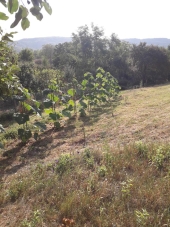posted 4 years ago
Hey, Joel.
You and I are in the same boat! Starting June 1, we began renting our barn to a 15 horse boarding operation, and I.had.no.idea how much manure horses produce (or manure/bedding). At our place, it's about 1-2 washing machine sized amounts per day. At best, OPTIMAL composting is a 60 day cycle (30 days to cook and 30 days to cure), and that's a lot of poo. (Ok, supposedly if you control for everything it's 18 days of cooking but I, also, don't have $60,000 to spend on a closed loop system).
I did quite a bit of research on this -- and honestly, right now I found a berry farm that takes most of it until I can get better. My first attempt didn't work, and trying to experiment at this volume is stressful. Fortunately, I have the land for it. Unfortunately, I don't have FLAT land for it.
(ok, wow. this was my first post and I didn't realize how LONG it was. sorry!)
However, here are some of the nuggets I found relevant. You can send me a note separately if you want some of the sources of info.
a. compost pile placement is important when it comes to water runoff vs. nearby animals, homes, streams/ponds.
b. make no mistake, this is a commercial size operation, and decent sized equipment is needed to manage it
c. manure that doesn't have enough water can't be fixed by adding water all at once, as compost is hydrophilic once it's in a big pile
d. making a big windrow and turning every once in a while does still produce compost action (albeit suboptimal). But when you DO turn the pile, boy does it stink! gack.
e. in my opinion, life is too short to spend turning the amount of poo being produced from 15 horses, even with a tractor. Although, to be honest, turning does provide an opportunity to add more water to a pile that might be too dry. Newer research indicates that the amount of oxygen added during turning is used up almost immediately so this is another reason to avoid turning very much.
f. I bought a bouncy house blower and re-used some pipe and some wood chips to push air through the pile. This gives me the benefits of adding the oxygen (i.e., avoid the smell) without having to turn it. HOWEVER, it looks like I either don't have enough water or enough nitrogen because the pile stalls out after a few days. Experimentation needed. Adding the air through a pipe that is under the pile is the aerated static pile process recommended by one of your other commenters.
g. apparently there's a great way to check to see if compost is cured by planting radish seeds in it. Any outcome other than healthy green seedlings means it's not done (e.g., no seedlings grow, seedlings grow but the leaves are yellow).
Regarding flies:
a. there are a number of different types of flies on a farm, the "filth fly" I *think* is the same as a house fly(?), and it lays its eggs in the top 1-2" of manure. You have about 7 days before an egg batch hatches. One way to limit this is to cover the currently composting pile with *finished* compost, which doesn't have all the bits the flies think are yummy. I haven't looked specifically to see whether a "ruth stout" deep layer of spoiled hay or straw would also work, but that's my current hypothesis.
b. fly predators work to keep down flies, but not in the currently composting pile, only in the "curing" and post-curing piles, as the optimal cooking temp (130-150) is too hot.
c. Apparently using fully composted manure as bedding is fairly common in the cattle industry, and has some light experimentation in the horse industry. I'm quite interested in this as a means to more fully incorporate a portion of the horse manure into a permaculture practice. Supposedly compost is more absorbent than other bedding materials, although it's hard to tell what's soiled since it's already dark.
What are you experimenting with at this time?
-Cindi

 2
2




 2
2








 2
2




 1
1




 2
2








 1
1




 1
1






 1
1








 1
1




 1
1




 1
1








 1
1




 2
2




 2
2




 2
2




 3
3




 2
2







 2
2









 3
3




 2
2
















